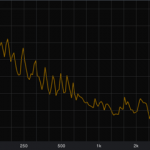
State of the Mix 2013: Reruns

I guess I’ve got a couple of new things I’ve been playing with lately that aren’t really new at all. If you’ve read the blog for a while, you’ve probably already figured out that I tend to cycle through different phases and then back around. It helps keep some things fresh for me.
Our drum shield is back up. I have mixed feelings about drum shields. I love the way the drums sound with the shield off, but I love the way the vocals sound with the shield up. We put it back up at the end of December as we approached the musical number for Christmas, and I decided to leave it up. Lately we’ve been using some great singers who just don’t have as much power as I’d like so it can be a constant fight to get enough vocal over the crash-ride cymbal fad I wish would die already. With the shield up I find I simply have cleaner vocals and more control over cymbals in the house. I’m sure I’ll pull the shield off again at some point, but for the near future I think it’s going to stay up.
This might legitimately be somewhat new for me…well, at least me doing it deliberately is probably new. Lately I’ve been compressing my vocals before I EQ them.
I’ve been using Waves Ren. Channel essentially as my primary channelstrip for vocals for a while now. My approach with compression is typically to EQ first so that I have my source cleaned up before I compress. What I was finding lately is after EQ’ing and then compressing I would invariably find myself going back to the EQ to fix/tweak something. In those cases I would do some whacky things to the signal when I started sweeping through the EQ because the additional boost on the EQ would drive harder into the compressor.
The Ren. Vox compressor setting I use is pretty transparent, but like any compressor it still affects the sound and tone of a signal when used. I guess I felt like I was chasing my tail sometimes going back and forth between the EQ and compressor settings so one day I flipped the signal path in the plugin to compress first, and I just got happier with the result faster. It doesn’t work for everyone, though, but it’s pretty nice to be able to just flip between the two right in the plugin. The bottom-line is my starting point these days is to compress the vocal first.
Most other instruments are still EQ first and then compression, though. Part of this might be because I try not to use much compression on the instruments. On the other hand, I can’t remember the last time I mixed a vocal without compressing it.
One thing I should note, though, is I still use a hi-pass filter ahead of all of this so that I can filter out any garbage first.

 Next Post
Next Post



Dave
Why no absorbers on the inside of the plexiglass? with some absorption the drums should sound better
Because that looks awful, and the improvement wouldn’t be worth it.
Dave,
How are you mic’ing your overheads now? What are your thoughts of mic’ing the cymbals from the the front of the kit on the sides? Correct me if I’m wrong, but don’t most audiences hear the cymbals from the sides rather than over the top? Currently I’m close mic’ing the crash cymbals overhead, ride, and high hat. So far it has given us more control over the kit in the mix for our room.
I have a stereo overhead mic in one of my rooms which captures the entire kit. I also always have a close mic on the hi-hat and ride in case I want to use them. It’s more for flexibility from week to week because not every drummer needs them, and it’s always easier to just have stuff setup than to have to go and set it up while a rehearsal is in progress.
I’ve never mic’ed cymbals from the front or sides of the kit, although I have close mic’ed them on top and underneath. I have had a couple friends who mic’ed their cymbals from the front corners of the kit, but they’re not doing it anymore. The mics were pseudo-room mics.
I’d say how the audience hears acoustic cymbals depends on the the venue and drummer’s cymbal setup. Some guys place their cymbals flatter than others. Some drums are on high stages and risers on top of that. It’s all variable. I would say fairly definitively, though, that an audience would hear the cymbals acoustically from the front of the kit.
I see a couple potential problems mic’ing cymbals from the sides–doesn’t mean you can’t do it, though. For starters, cymbals are relatively thin and a true moving target when struck. I can’t say definitively because I’ve never tried to mic one really close from the side, but I’d guess there would be weirdness as it moves above and below the diaphragm of the mic. Second, if you pull the mics farther away you’re going to start capturing more than just the cymbals which may or may not be desirable.
Overhead mic’ing works well because the mics can be positioned overhead to capture a more balanced sound either from a specific cymbal or the entire kit.
Thanks for your thoughts Dave.